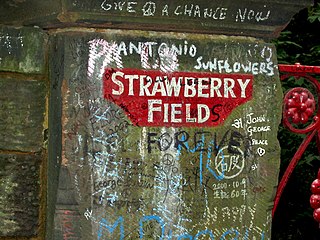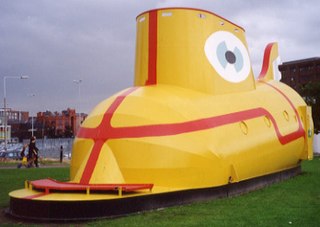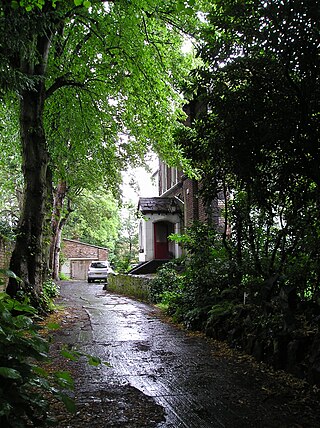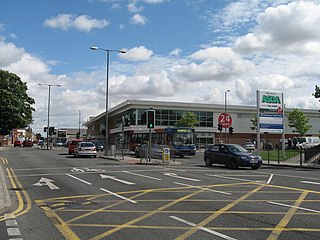
Strawberry Field is a Salvation Army property and visitor attraction in the Liverpool suburb of Woolton. It operated as a children's home between 1936 and 2005. The house and grounds had originally been built as a private residence in the Victorian era, before being acquired by the Salvation Army in the 1930s. The house was demolished in 1973 due to structural problems and replaced with purpose-built units. After being closed as a children's home, the site has continued to be used by the Salvation Army for other purposes.

Gambier Terrace is a street of 19th-century houses overlooking St. James's Mount and Gardens and Liverpool Cathedral. It is generally reckoned to be in Canning, although it falls within the Rodney Street conservation area, together with Hope Street and Rodney Street.

Cynthia Lennon was the first wife of John Lennon and the mother of Julian Lennon.

Allerton Cemetery is a cemetery in Allerton, Liverpool, England. The cemetery, of 150 acres (61 ha), is one of the main burial sites for the Metropolitan Borough of Liverpool and is Grade II listed. Springwood Crematorium is situated opposite the cemetery on Springwood Avenue. Purchase of the land for the cemetery was completed in October 1906, the Church of England section was consecrated by the Bishop of Liverpool on 24 September 1909, and the first burial in the cemetery took place on 29 December 1909. It is still in operation.

Hope Street in Liverpool, England, stretches from the city's Roman Catholic cathedral, past the Anglican cathedral to Upper Parliament Street and it is the local high street of the Canning Georgian Quarter. It contains various restaurants, hotels and bars and is one of Liverpool's official 'Great Streets' and was also awarded 'The Great Street Award' in the 2012 Urbanism Awards, judging it to be the best street in the country. The road runs parallel to Rodney Street. Together with Gambier Terrace and Rodney Street it forms the Rodney Street conservation area.

The Cavern Mecca was a Beatles museum in Liverpool. Founded in 1981 and named for the Cavern Club, it was instrumental in the birth of Beatles fan-based tourism in Liverpool. It was located on the corner of Rainford Square and Mathew Street.
William Harry is the creator of Mersey Beat, a newspaper of the early 1960s which focused on the Liverpool music scene. Harry had previously started various magazines and newspapers, such as Biped and Premier, while at Liverpool's Junior School of Art. He later attended the Liverpool College of Art, where his fellow students included John Lennon and Stuart Sutcliffe, who both later performed with the Beatles. He published a magazine, Jazz, in 1958, and worked as an assistant editor on the University of Liverpool's charity magazine, Pantosphinx.

Liverpool College of Art was located at 68 Hope Street, in Liverpool, England. The college was housed in a Grade II listed building, which still stands. The original building, facing Mount Street, was designed by Thomas Cook and completed in 1883. The extension along Hope Street, designed by Willink and Thicknesse, opened in 1910. The building was until 2012 owned by Liverpool John Moores University. The university's School of Art and Design moved out of the building to new premises at the Art and Design Academy in 2008. 68 Hope Street also currently houses the School of Humanities and Social Science.

Alfred Lennon, also known as Freddie Lennon, was an English seaman and singer who was best known as the father of musician John Lennon. Alfred spent many years in an orphanage with his sister, Edith, after his father died.

The Yellow Submarine in Liverpool is a large model representation of the submarine featured in the 1968 animated film Yellow Submarine, inspired by the 1966 song of the same name on The Beatles' album Revolver. It was built by a group of about 80 apprentices from Cammell Laird's shipyard, designed in part by Mr L Pinch, a draughtsman at the yard, for exhibition at the International Garden Festival in Liverpool in 1984. The Submarine was in a garden themed around the Beatles, one of 60 such themed gardens, and was highly popular. The garden took the form of an apple-shaped labyrinth, containing symbolic references to the group, and included a bronze statue of John Lennon, which now stands at Liverpool John Lennon Airport.

The Casbah Coffee Club, officially Casbah Club, was a rock and roll music venue in the West Derby area of Liverpool, England, that operated from 1959 to 1962. Started by Mona Best, mother of early Beatles drummer Pete Best, in the cellar of the family home, the Casbah was planned as a members-only club for her sons Pete and Rory and their friends, to meet and listen to the popular music of the day. Mona came up with the idea of the club after watching a TV report about The 2i's Coffee Bar in London's Soho where several singers had been discovered.

Stanley Street, in the centre of Liverpool, England, runs south between Dale Street and Whitechapel. As well as being home to numerous businesses ranging from estate agents, solicitors, bars and restaurants, there are also apartments in upper floors of some of the buildings. As part of the Big Dig, the southern half of the street between Whitechapel and Victoria Street was repaved in 2007, and is used as a taxi-rank serving Liverpool's central shopping district and Mathew Street.

Phillips' Sound Recording Services was a studio in the house of Percy Francis Phillips (1896–1984) and his family at 38 Kensington, Kensington, Liverpool, England. Between 1955 and 1969, Phillips recorded numerous tapes and acetate discs for Liverpool acts, people and businesses in a small room behind the shop his family owned.

The Cavern Club is a music venue on Mathew Street, Liverpool, England.

The Blue Angel, also known as "The Raz" is a nightclub in Liverpool, England. It is located where Seel Street meets Berry Street in Liverpool city centre. It is a venue in Liverpool in which The Beatles, Rolling Stones, Bob Dylan and many other bands played at in the 1960s. It was historically a jazz club, but it now plays pop music.

Smithdown Road is a historic street in Liverpool, England, which now forms part of the A562. The area was previously known as Smithdown and dates back to 1086 when it was listed in the Domesday Book. The causeway that actually became what is now Smithdown Road emerges in documentation around 1775.

The John Lennon Peace Monument, also known as the European Peace Monument, is a peace monument entitled Peace & Harmony in Liverpool, England, dedicated to the memory of John Lennon. Peace & Harmony was unveiled by Julian and Cynthia Lennon at a ceremony in Chavasse Park, Liverpool, on Saturday 9 October 2010 to celebrate what would have been John Lennon's 70th birthday. The monument is now on the waterfront adjacent to ACC Liverpool at Kings Dock.

The Hard Days Night Hotel is a four star hotel located on North John Street in Liverpool, England. One of the only Beatles themed hotel in the world, it is named after their film, album and song A Hard Day's Night.

Eleanor Rigby is a statue in Stanley Street, Liverpool, England, designed and made by the entertainer Tommy Steele. It is based on the subject of the Beatles' 1966 song "Eleanor Rigby", which is credited to the Lennon–McCartney partnership.

Falkner Street is a street mostly in Canning, with a short section in Edge Hill, Liverpool, England. The street, built during the early-mid 19th century, is named after Edward Falkner, who had previously commissioned the construction Falkner Square. Constructed at a time when Liverpool had less than 100,000 houses, the Falkner Street houses sold for around £1,000 and were affordable to only the wealthiest 1% of the population.



















